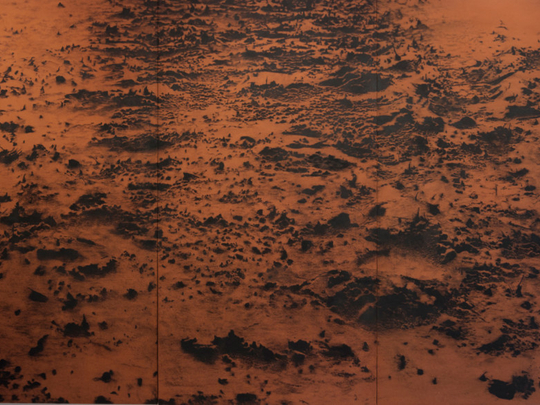
Farjam Foundation’s summer exhibition, Out of Focus/Union sets up a dialogue between artists from India, Pakistan, Iraq and Iran to explore the borders between countries, cultures and civilisations. It features artworks from the Farjam Collection by Chahine Khosravi, Afshan Daneshwar, Halim Al Karim, Imran Channa and Saad Quereshi and a commissioned work by Owais Husain.
The show looks at intangible notions of identity, memory, past and belonging through the perspectives of artists who have personal experience of displacement and migration. It questions the blurred borders that divide us by highlighting the divergences and convergences between neighbouring countries and the collective consciousness that connects people across physical, cultural and ideological boundaries.
The show’s theme of blurred borders, identities and perceptions is reflected in the out of focus imagery in many of the works such as Khosravi’s oil paintings from the Chess Players series. In these monochromatic paintings the France-based Iranian artist has depicted hazy, almost abstract figures of chess players, alluding to the strategic moves and power plays that divide people. But the figures merge with one another and with the background suggesting a unity that lies beyond our perceived differences.
Qureshi’s installation, Borrowed from the Shadows, featuring a long-knotted keffiyeh placed on the floor refers to the common geographical and historical roots that the Palestinians share with their neighbours despite the conflicts between them. Other works by the British artist of Pakistani origin include a textured mixed media triptych titled Time/ Memory/ Landscape featuring a mystical landscape created with ash, brick-dust, charcoal and ink on wood. The imaginary vista represents internal and external landscapes, conveying the idea of memory and visualising a place where one’s past and identity can be anchored.
Al Karim was born in Iraq, spent his childhood in Beirut and now lives in the US. He has experienced the persecution of his family for their opposition to the then Iraqi regime and when forced to join the military he fled to the desert where he lived in a hole in the ground for almost three years. He survived thanks to an elderly Bedouin woman who brought him food and water, and taught him about gypsy customs and mysticism. His life and art have been profoundly affected by this experience.
The artist works mainly with photography, blurring, obscuring and distorting his images to express ideas of displacement, migration and questioning the notion of home. Inspired by stories of mythological deities he began a series titled Goddess in 1985 which pays homage to the women who protected him during times of violent upheaval, while also exploring the idea of femininity in a world where women are oppressed but also elevated to the status of a deity. The show includes the first work from this series titled, Goddess of Beirut, featuring hazy images of two veiled women. The out of focus black and white photograph implies an uncertainty of context, time and place and the desire to look beyond political deceptions for a greater truth.
Multi-media artist Channa lives between Pakistan and the Netherlands. He is interested in examining how history is recorded, framed and manufactured through photography, archaeology and literature and how these are used for the perversion of knowledge and the construction of consciousness. The blurred charcoal drawing from his Memories series presented in this show refers to the partition between India and Pakistan and expresses a hope for peace between the two neighbours who share the same history and culture.
Dubai-based Indian artist Husain’s installation titled, The Inventory of History, features a set of compressed travel trunks placed in an amorphous arrangement on the floor, with video screens inside some of them.
“The trunks are a symbol of movement and displacement, and a storehouse of memories. The compression of these trunks represents the vacuum created by the loss of one’s identity, but the patina on the trunks conveys a sense of hope as we shed our baggage and merge our past with the present to evolve a new hybrid identity. The slow-moving images of rivers, lakes, rocks and grass fields seen on the screens inside the trunks play with the element of time signifying the desire to hold on to one’s memories and identity in a changing world. The lacelike structure covering the work is cut from heavy steel and rests on mismatched wheels reflecting the instability of our times. But this work also speaks about the fact that when you travel you find that other places are not so different from your own home and that ultimately human nature and emotions tie us all together,” Husain says.
Dubai-based Iranian artist Daneshwar’s work from her Nafas series also speaks about what unites us all. “Nafas means ‘breath’ in Urdu, Farsi and Arabic, and my aim is to visualise breath, which is a universal sign of life, but one that we barely perceive. In this work I have embossed the word Nafas 25,000 times on a long roll of white paper to represent the number of breaths a person takes in a day,” she says.
Out of Focus/Union will run at The Farjam Foundation DIFC until July 31.













